 |
Figure 1: Optimum Exchanger Model
Appendix A- PFD for Reforming in an Ammonia Plant
Appendix B- Stream Compositions
Appendix C- Utility Heat Exchangers Model
The system under consideration has two streams in need of heating and cooling. The hot stream runs from the secondary reformer to the absorber at a pressure of 35.29 bar. It is a vapor stream consisting primarily of steam, H2, and N2, with small amounts of CO, CO2, CH4 and Ar. It requires cooling from 995.8 °C to 250 °C. The cold stream is the combined feed of methane and steam that needs to be heated before entering the primary reformer. Its primary constituents are steam and CH4, with traces of CO2 and N2, and it must be heated from 231.1 °C to 600 °C, at 39.22 bar. The actual compositions of the streams from the previous projects used in this system are given in Appendix B. The temperature requirement for the stream going to the absorber was taken from the separators project, and the remaining stream specifications were from the reactors project.
In choosing a property set for simulation, the NRTL equation was considered initially because it is commonly used in industry and acedemia. However, the recommended conditions for its use were not applicable to the system under consideration. After researching other available property sets in Aspen, it was determined that the Peng Robinson - Boston Mathias (PR-BM) property set best suited the needs of the system. The PR-BM property set is commonly used for gas processing, especially for mixtures of light gases, such as H2 and CO2. Reasonable results are expected at all temperatures and pressures with the PR-BM property set, an important consideration given the extreme temperatures and pressures of the reforming system.
There was not enough duty available in the cold stream to cool the hot stream to the necessary
250 °C. A cooler needed to be added to the system, either prior to the heat exchanger
to start the cooling process, or following the heat exchanger to complete the cooling of the
hot stream. The latter was chosen because the temperature difference between the hot and
the cold streams was much less than that of the cooling water and the hot stream. The
lower temperature difference is desired to reduce wear on the exchanger. Figure 1 shows
the diagram of these two exchangers as modeled.
 |
A tube and shell heat exchanger was chosen for the primary exchanger. Tube and shell is the most commonly used type (Perry 11-33). The two streams were crossed, the hot stream in the shell, and the cold stream in the tubes. This decision was made because tubes are easier to clean than the shell, and the cold stream contains an appreciable amount of methane which could coke at these high temperatures.
Once the exchanger system was decided upon, a rigorous analysis of the primary heat
exchanger was necessary. The exchanger was specified as TEMA type CFU, class R. Type
C allows for a removable tube bundle, type F specifies a two pass shell, and type U specifies
a U-tube bundle (Gas 9-15). A diagram of what this exchanger might look like is
included in Figure 2. Class R allows for extreme conditions, such as the high temperatures
and pressures of this system, by designating conservative calculations (Branan 22). The
removable tube bundle allows the tubes to be cleaned easily, which would most likely be
done by hydroblasting. Access for cleaning is essential to the function of the system. U-tubes
were chosen because they allow for expansion of the tube bundle. Material expansion
is an important consideration in our system given the large temperature difference
between the hot and cold streams (Branan 24). If a fixed tube sheet were used, an expansion
joint would be necessary (Branan 25). Expansion joints are costly and a potential
source of hazardous leaks. The two pass shell design is most common and delivers higher
efficiency in heat exchange. In order to minimize the necessary utility costs, maximum
cooling must occur in the exchanger, and this is assured with the two pass shell design.
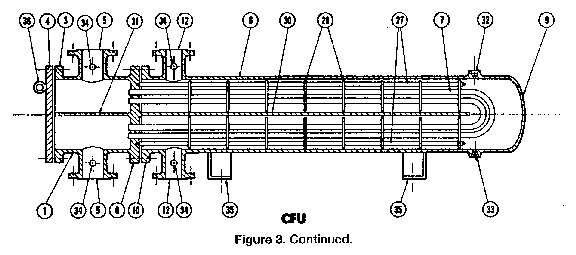 |
The exchanger was defined as vertical, hot shell-cold tube exchanger constructed of Incoloy, 800 series. Incoloy 800 is a 21:32:47 Cr:Ni:Fe alloy (Perry 28-64). It is one of few materials that can withstand temperatures up to 1100 °C (Perry 28-50). In addition to its high temperature tolerance, incoloy should be used in this system because it is resistant to hydrogen attack. Hydrogen pitting could lead to embrittlement and possible process stream contamination or material failure in many other common materials at the high pressure of H2 present in the hot stream of this system (Branan 231-232, 235). The tubes will also be thicker-walled than standard to contain the high pressures in both streams.
The surface area necessary for this exchange was calculated by Aspen to be 120.2 m2. Then, the number and size of the tubes was calculated to support the required heat exchange area. The optimal system consisted of a tube sheet of 100, 1.5 inch diameter, 36 foot long tubes with a 4.5 inch pitch and arranged in a triangular pattern. The 4.5 inch pitch is slightly greater than minimum, because the shell-side flow is large (Branan 29). The baffles were placed 2 feet apart to allow for optimal flow on the shell side and adequate tube bundle support (Perry 11-42). The nozzle sizes were determined to be 12" shell side and 10" tube side by finding the smallest nominal size which gave reasonably low pressure drops and fluid velocities (Branan 26-29). The pressure drop data can be found in Appendix B. These specifications lead to a heat exchanger that is 52 inches in diameter and 36 feet in length, with additional length required for the channel end (the left side of Figure 2).
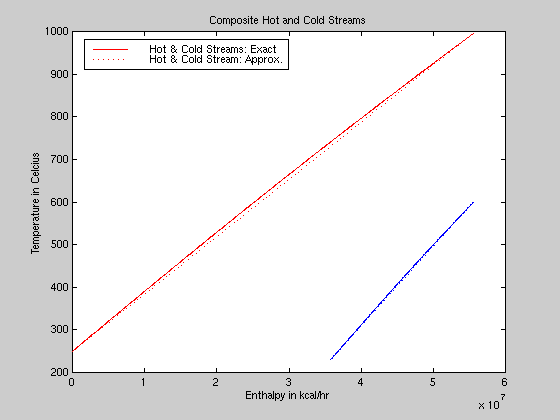 |
The inverse of these slopes then became the F*Cp's for use in later parts of the Matlab program.
Then the htxcc1 program was used with the overall heat coefficient, U, from the
Aspen short cut method to double check the accuracy of the Aspen result. Matlab gave a
surface area very close to Aspen's calculation. Unfortunately, the U provided by Aspen is
not considered very accurate, so another program was written to estimate an overall heat
transfer coefficient separately from Aspen.
Since a rough approximation was desired, most values were taken to be average or bulk
values, and the following equation was used to find the heat transfer coefficients of each
stream (Bird 399):

The temperatures used to find the various stream properties were the average temperatures of each stream. The thermal conductivities, k, were from the mixkt program, the viscosities from the mixmu program and the Prandtl numbers from the mixpr program. We were unable to find the thermal conductivity of the Incoloy metal, so we guessed a value based on similar metals. Considering these approximations, Matlab's value for U being within a factor of three from that gotten by the rigorous model in Aspen, allowed more confidence in the rigorous model calculation (unlike the short-cut method which was over an order of magnitude off).
Lastly, the first program was run again using the U from the rigorous Aspen model to find
a surface area of 114.7 m2 (which closely matches Aspen's value) and the following graph
for a one-pass heat exchanger.
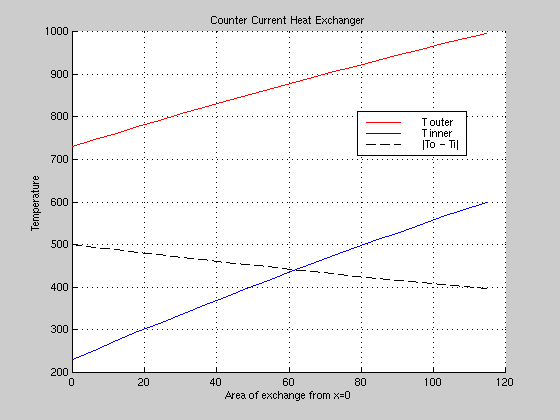 |
Various tube number and length combinations were simulated. Fewer, longer tubes created an excessively long exchanger and increased the cost of the unit, while a greater number of shorter tubes led to pressure drops and velocities that were too high in the tubes. Once again, given the specific space requirements of the individual plant, these alternate systems should be considered further. Whether the exchanger should be vertical or horizontal is also a decision that should be made later when the plant plot arrangement and available support/access structures around the unit are known.
For cost analysis purposes, the cost of purely utility supported heating and cooling systems was compared to the optimum exchanger system design. Heating the cold stream from 231.1 °C to 600 °C requires 19.79 MMKcal of duty which costs $180 per hour ($1,578,966 per year) in steam. This estimate comes from Dupont's Victoria plant steam cost of $2.30 per million Btu. There are some cooling water requirements in the optimum design for the final cooling of the hot stream, but the cost of cooling water is insignificant in comparison to steam. Essentially it is only the cost of the treatment and the pumping. The amount of cooling water required has been reduced through the integration of the heat system.
1960. pp. 399.Branan, Carl R. Rules of Thumb for Chemical Engineers. Gulf Publishing Company.
Houston. 1994. pp. 19-30, 231-235.Gas Processors Association. "Heat Exchangers." Engineering Data Book, Volume I. Gas
Processors Suppliers Association. Tulsa, OK. 1987. Section 9, pp. 1-18.Perry, Robert H. and Green, Don W. Perry's Chemical Engineer's Handbook. McGraw-
Hill. New York. 1997. pp. 11-33, 11-42, 28-50, 28-64.
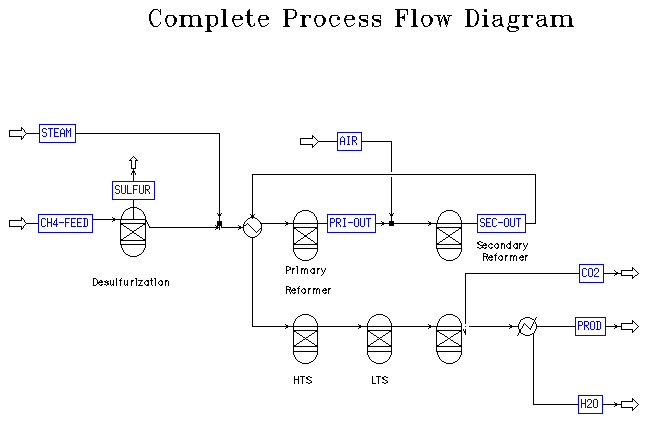 |
| FEED | PRIM-IN | SEC-OUT | HOT-OUT | ABS-IN | |
|---|---|---|---|---|---|
| Temp (°C) | 231.1 | 600 | 995.8 | 741.0 | 250.0 |
| Pressure (bar) | 39.22 | 38.75 | 35.29 | 34.647 | 35.29 |
| Vapor Fraction | 1.00 | 1.00 | 1.00 | 1.00 | 1.00 |
| Enthalpy (MMkcal/hr) | -231.935 | -212.135 | -154.969 | -174.768 | -210.383 |
| Mole Flow (kmol/hr), total | 5004.443 | 5004.443 | 8828.312 | 8828.312 | 8828.312 |
| CH4 | 1250.0 | 1250.0 | 21.281 | 21.281 | 21.281 |
| H2O | 3750.0 | 3750.0 | 2832.839 | 2832.839 | 2832.839 |
| H2 | - | - | 3374.600 | 3374.600 | 3374.600 |
| CO | - | - | 814.477 | 814.477 | 814.477 |
| CO2 | 3.000 | 3.000 | 417.242 | 417.242 | 417.242 |
| N2 | 1.443 | 1.443 | 1350.593 | 1350.593 | 1350.593 |
| Ar | - | - | 17.280 | 17.280 | 17.280 |
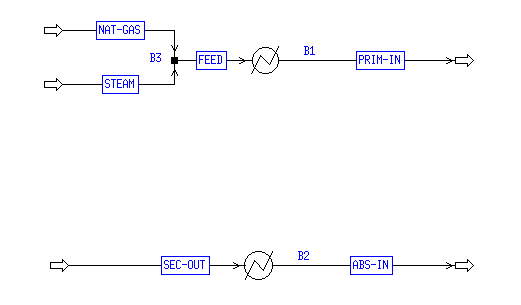 |